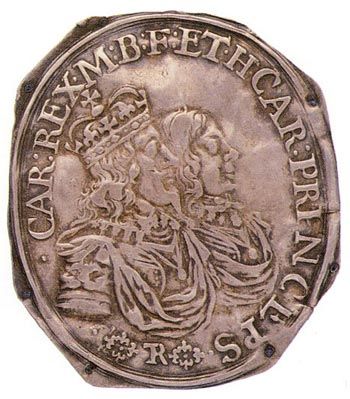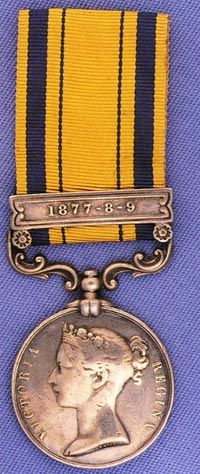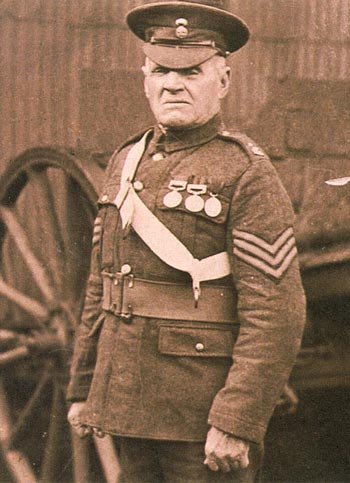Distinguished Service - campaign & gallantry medals
The medal collections of Amgueddfa Cymru

Silver 'Forlorn Hope' badge 1643 — this would have been sewn onto a sash or tunic.

South Africa Medal 1877-79: '1428 Pte E. Jones 2.24th Foot'.

Sergeant Evan Jones, c.1917. He was born in Ebbw Vale in 1859 and enlisted in the Monmouth Militia in 1874, joining the 24th Foot in 1877. He served in South Africa, where on 23 January 1879 he was one of the tiny garrison that held Rorke's Drift against a massive Zulu attack. He later served in the Mediterranean, India and Burma, and remained in uniform with various units until 1920. He died in Welshpool in 1931.
The British medal collections of Amgueddfa Cymru were formed back in the 1920s thanks to gifts from two men.
In 1922, Colonel Sir William Watts donated his collection of 105 British naval and military medals, and in 1923 W. Lisle Bowles made generous gifts of similar medals.
From these, the Museum gained a representative collection of British military campaign medals, from the battle of Waterloo (1815), the first engagement for which all who took part received a medal, to the Great War of 1914–18 and beyond. However, only a small number of these military and gallantry medals had any Welsh associations.
In more recent years, therefore, occasional purchases and donations have concentrated on these two categories, our stated policy being to collect medals 'relating to the deeds of Welsh people'.
'Forlorn hope'
The earliest military award in the collection is a badge for the 'Forlorn Hope', dating from the English Civil War and awarded to selected troops who acted as vanguards. This was a Royalist award introduced in 1643 by Thomas Bushell, a mining engineer and master of the mint at Aberystwyth.
Civilian Heroes
The Albert Medal was introduced in 1866, at first awarded for gallantry at sea, but extended to the saving of life on land in 1877 to reward the heroes of Tynewydd Colliery, Rhondda, for the successful rescue of five colleagues trapped by flooding for nine days deep underground. Several Albert Medals relating to this incident are in the Museum's collection. When the Edward Medal was created in 1907 for gallantry in mines and quarries, one of the first two awards went to a Welshman, Henry Everson, of Penallta Colliery; the medal was donated to the Museum by his son in 1978.
From Albert to Edward to George
In December 1971, the Albert and Edward Medals were withdrawn, to be replaced by the George Cross. Of those who elected to exchange awards, seven chose that their previous medals be donated to the Museum. Two of these, Gordon Bastian and Eynon Hawkins, held the Albert Medal for gallantry at sea, having rescued fellow crewmen in torpedoed ships in 1943. Three 'land' Albert Medals are those of Walter Cleall; Cardiff policeman Kenneth Farrow, who attempted to save a small boy from drowning; and Margaret Vaughan, who as a schoolgirl saved a boy caught by the rising tide at Sully Island, near Barry, from drowning. Edward Medals were given to Bert Craig (Mountain Ash, 1922) and Thomas Thomas (Brynamman, 1933).
Heroism and Great Gallantry
In 1990, the Museum acquired three George Medals with Welsh connections.
The George Cross and George Medal were created in 1940, primarily as a response to the increased exposure of civilians to great danger during the Blitz. On 19 August 1940, the Royal Naval fuel depot at Llanreath, Pembrokeshire, was bombed and burned for seventeen days, destroying over thirty million gallons of oil. This was the biggest fire ever known in Britain. Norman Groom was one of 650 firemen who fought the blaze and one of three Cardiff men to receive the George Medal. Thomas Keenan, a nightwatchman, removed an incendiary bomb from the top of a tank containing 300,000 gallons of petrol at a depot in Ferry Road, Cardiff, on 2 January 1941.
The awards highlighted here form just the tip of a historical iceberg. Unlike those of any other country, Britain's campaign medals and most of its gallantry awards have, since the early 19th century, been impressed with the name (and for military awards the number, rank and unit) of their recipients. Even the millions of campaign stars and medals of the Great War of 1914–18 were individually named, though those of the Second World War were issued unnamed, presumably to save costs. Most medals are, therefore, starting points for historical research into the lives of individuals.
Comments - (6)
S
Thank you for your enquiry, I have just asked our Numismatist to advise where this medal is currently located. I'll get back to you when I hear.
Thank you,
Graham Davies, Online Curator
Edward Medal, 2nd Class, Mine: George Jones
Dublin Main colliery, 5 August 1910. London Gazette Issue 28551, 17 November 1911
The London Gazette entry reads:
'His Majesty the KING has also been pleased to award the Edward Medal of the Second Class to George Jones and Hugh Roberts.
'On the 5th August 1910, a serious explosion, causing the loss of two lives, occurred at the Main Coal Colliery, Northop, near Flint, owing to the ignition of fire damp by a shot fired to bring down coal. Jones, the fireman in charge at the time of the explosion, was severely injured; but, although a fire was known to be burning in the mine, he returned twice to the workings in search of one of the men under his charge who was believed to be missing. On the second occasion Jones was accompanied by Roberts, a timberman, who subsequently went into the mine in order to extinguish the fire.'
The original can be viewed at www.gazettes-online.co.uk.
Select London and search the archive.
Diolch am ddangos pethau fel hyn i\'r plant ac i ni.Yr ydym i gyd yn cael digon o newyddion am y pethau drwg mae bobl yn gwneud.